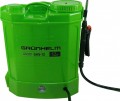Productivity (liquid)
Maximum performance of the sprayer when working with liquid; Please note that in pump (see "Type of pumping") and battery (see "Type") models, the actual performance may decrease as the air supply or battery charge is exhausted.
High performance allows you to quickly process large areas; moreover, it is often combined with a good spraying distance (see below). On the other hand, such models require fairly large tanks — or they often have to be refilled; neither one nor the other contributes to the convenience of work. In addition, over-capacity is even more undesirable than under-capacity: a low-capacity sprayer will just take longer to process, and a too-capacity sprayer can ruin the job by “overdosing” the chemical. Therefore, it makes sense to use high-performance devices only for specific tasks.
Detailed data on optimal performance values for different situations can be found in special sources.
Max. spraying distance
The longest distance a sprayer can effectively spray a liquid or powder. Usually, the horizontal range is implied, however, for “long-range” models, values bare also given for vertical spraying — in such units, the difference between horizontal and vertical ranges can be very noticeable.
A “long-range” sprayer (for
10–15 m or
more) is convenient in that it allows you to process a large area without moving, and also to reach high branches without using ladders. On the other hand, a long range requires appropriate power, which affects the price, weight and dimensions of the unit — despite the fact that such capabilities are not always required: for example, for a cramped greenhouse, an atomizer with a short range (
5 – 10 m, and often and
less) So it is worth choosing according to this indicator, taking into account the features of the planned work.
Max. pressure
The maximum operating pressure of the sprayer.
High pressure allows to achieve good spraying performance and range, however, actual performance can vary with units with the same pressure. Therefore, in general, the indicator is for reference (the lion's share of models has a
pressure of 3 bar and
4 bar, and it is only possible to compare different models by it approximately. When choosing, it makes sense to focus on more practical characteristics — performance, range, etc.
Max. fluid temperature
The maximum fluid temperature that the sprayer can safely handle.
The preparation process of some formulations requires heating; therefore, data on the temperature to which the liquid must cool can be very important for safe operation. However, even in the most heat-resistant sprayers, this figure does not exceed 40 °C; such a liquid feels warm to the touch.
It is worth remembering the temperature limits when the unit is in the sun: if the tank has had time to get very hot in the sun, you should let it cool down before starting work.
Operating time
Time of continuous operation of the battery sprayer (see "Type") on one battery charge. The actual operating time may differ slightly from the claimed one due to the specifics of a particular situation, however, these differences are usually not very large, and this indicator can be used to evaluate not only theoretical, but also practical indicators of battery life.

